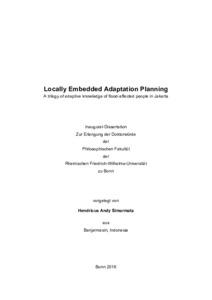Online-Ausgabe in bonndoc: https://nbn-resolving.org/urn:nbn:de:hbz:5-44290
urn: https://nbn-resolving.org/urn:nbn:de:hbz:5-44290,
author = {{Hendricus Andy Simarmata}},
title = {Locally Embedded Adaptation Planning : A trilogy of adaptive knowledge of flood-affected people in Jakarta},
school = {Rheinische Friedrich-Wilhelms-Universität Bonn},
year = 2016,
month = jul,
note = {Floods increase the vulnerability of the residents of flood-prone areas and affect their everyday lives. Minimizing the impact of floods requires an adaptation plan, especially at the community level. Moreover, cities and communities need a synergized response plan. A study based strictly on technical science would not determine the essential meaning of adaptation planning as experienced by a vulnerable people. The planning knowledge of adaptation that is generated by the flood experiences of the urban poor—the most vulnerable group—must be disclosed. We need to know more about the “lived experiences” of people’s adaptation to floods and the meanings that these people ascribe to their everyday lives. Therefore, only a people-centered approach can ascertain how the urban poor adapt to the floods.
Drawing on Schütz’s concept of lifeworld and twelve months of fieldwork in Kampung Muara Baru (KMB) Jakarta, this research investigates how individuals use their lifeworld as a basis for practicing and institutionalizing their community’s planning for adaptation. I begin with the context and locus of the adaptation planning studied in the present research, and I formulate two sub-questions: What kind of planning institutions is constituted in Jakarta? How does KMB represent the interplay between poor residents and regular floods? I then focus on the adaptation practices of the KMB people, especially their perceptions of their own flood-related vulnerability. Second, I identify the meaning of adaptation planning, and I examine the institutionalization and reification of the adaptation plan. I apply the lifeworld analysis to examine the concepts of vulnerability, adaptation, and planning. In addition to examining the secondary data, I collected primary data in the forms of participant observations, in-depth and semi-structured interviews, group interviews, historical transect, and focus group discussions. This research is expected to provide a better understanding of the appropriateness of the lifeworld concept in planning practices and to extend the horizon of phenomenology in planning.
This study found that more than one kind of adaptation planning addressed flooding in Jakarta. At the city level, the plan was to control the floods; at the community level, the plan was to live with them. This divergence was caused by discrete departure points, different planning methods, and varying sources of knowledge. It thus interfered with the institutionalization of planning because the divergent worlds of city and kampung were not connected. The results showed that, as an agglomeration of kampungs, Jakarta should understand the relationship between floods and the urban poor within the kampungs. Even though KMB had the greatest flood risk and id the poorest settlement in the Penjaringan sub-district, the recurrent floods do not discourage migration into and the spread of housing in KMB. Instead, flood incidents have become major inundation events because of KMB’s high-density settlement and poor drainage system.
Based on the in-depth analysis of the lifeworld of the people affected by flooding in KMB, I found that the poor who lived in the flood-prone area were not always vulnerable. Lived experience is an important factor that makes a significant difference between the vulnerable and the adapters. Lived experience is a source of the practical knowledge that is useful in planning. The structure of the lifeworld delineated the zone of planning operations and adaptation practices and thus resulted in short-term perspectives, neighborhood scaling, and problem-solving orientation, rather than long-term, citywide scaling, and visionary planning. The KMB people do not plan to stop or to mitigate the floods but to adjust their houses and surroundings to reduce the consequences of flooding and develop an evacuation pathway based on their lived experiences. Thus, their adaptation planning is locally embedded.
Because the inter-subjectively shared meaning process has produced locally embedded planning, is the findings showed a strong ownership of adaptation planning. The KMB people embodied the plan through the self-interpretation and self-reflection of what their predecessors and others had shared. Subsequently, they discussed the substance of the planning in order to make deliberate decision about the course of a series of social events, such as kerja bakti (working together in voluntary services), arisan (regular social gatherings), pengajian (routine Muslim praying), and casual events, such as warung (small shop) talks and alley chats. Therefore, they arrived at a verbal plan that was never written. They preferred listening to reading and talking to writing. Even though the plan consisted of loose-fitting regulations without clear penalties for violations, they teased and made fun of those who did not accomplish their tasks or broke the oral agreement.
Based on the lifeworld analysis of flood-related vulnerability, adaptation, and planning as the embodiment of a people-centered approach, I created a model of locally embedded adaptation planning. This six-step protocol consists of identifying the adapters, compiling precedents, revealing and assessing the locally situated form of knowledge, facilitating the sharing process, establishing the oral consensus, and dividing the tasks and responsibilities. This model contributes to the ongoing debate on adaptation planning in the context of climate change adaptation and disaster risk reduction as an alternative, insightful approach to linking coping strategies to adaptive capacity. In terms of flood management, the model of locally embedded adaptation planning explains the relationship between the flood responses that are needed and those provided by the community. The model thus strengthens the response strategies in flood management to prepare a resilient community. Finally, in term of planning practices, this model incorporates the humanistic values into adaptation planning through lifeworld analysis.},
url = {https://hdl.handle.net/20.500.11811/6801}
}






